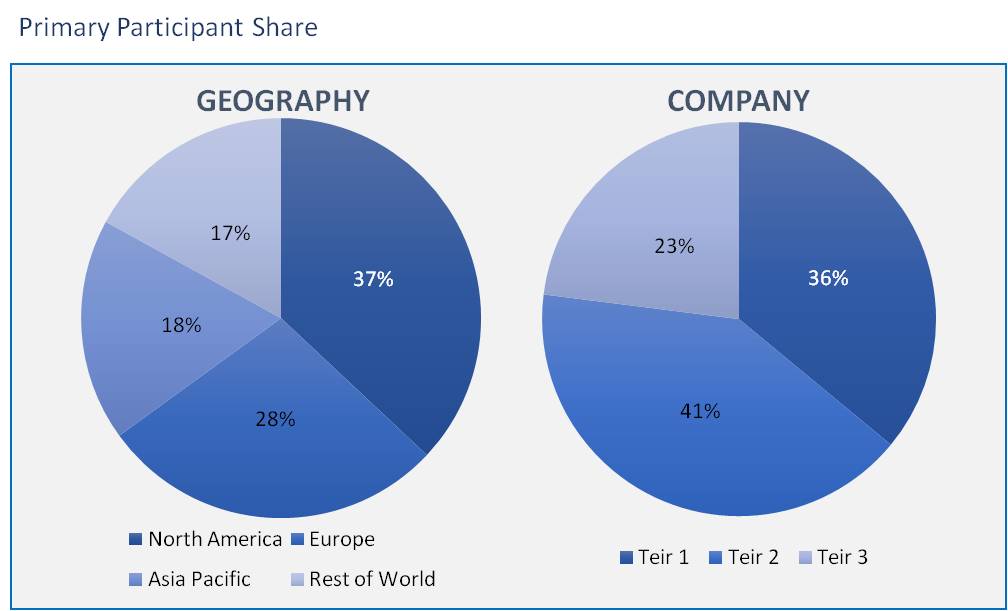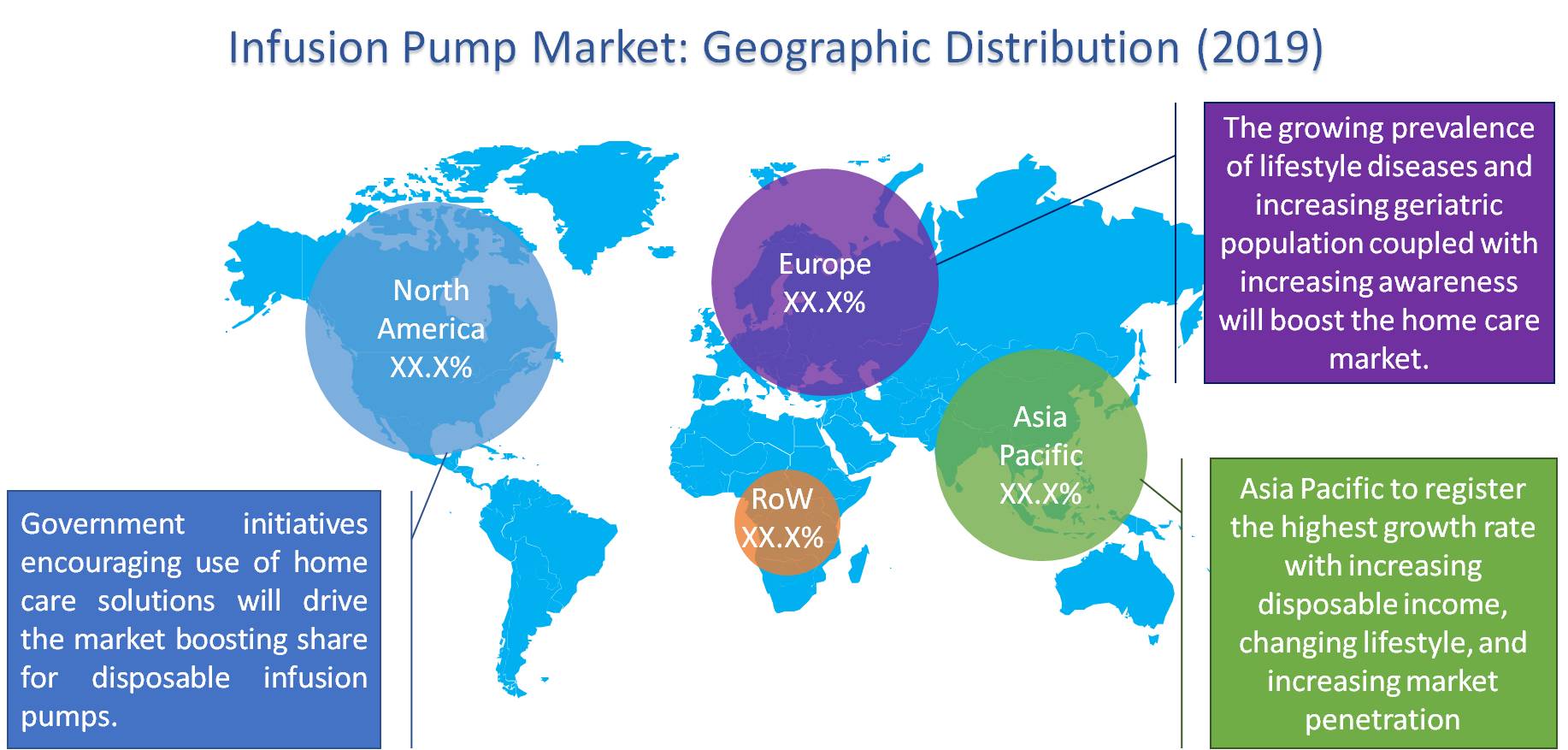
Infusion Pump Market By Product (Accessories & Consumables and Devices), Application (Chemotherapy/Oncology, Diabetes, Gastroenterology, Analgesia/Pain management, Pediatrics/Neonatology, Hematology, Other Applications), End Users (Hospitals, Home Care settings, Ambulatory care settings, and Academic and Research Institutes), Geography (North America, Europe, APAC, and RoW)– Forecast upto 2026
- July, 2020
- Domain: Healthcare - Medical Devices
- Get Free 10% Customization in this Report
Infusion Pump is a device capable of infusing fluids, such as nutrients and medication into the body in small, large or controlled amounts. The fluids such as insulin, antibiotics, chemotherapy drugs and pain relievers are some of the fluids which through infusion pump are transferred in to the body. Infusion pumps are generally used for intravenous and also for subcutaneous, arterial and epidural infusions occasionally.
Research Methodology:
The infusion pump market has been analyzed by utilizing the optimum combination of secondary sources and in-house methodology, along with an irreplaceable blend of primary insights. The real-time assessment of the market is an integral part of our market sizing and forecasting methodology. Our industry experts and panel of primary participants have helped in compiling relevant aspects with realistic parametric estimations for a comprehensive study. The participation share of different categories of primary participants is given below:

The driving factors in this market are increase in the chronic diseases, rise in the geriatric population, and rapid growth in the usage of ambulatory infusion pumps for the homecare purpose and increased surgical procedures. The developing countries such as India and China are adopting the specialized infusion pumps which give the opportunities for the vendors in the infusion pump market. The Infusion Pump Market is expected to reach USD 20.6 billion by 2026 from an estimated value of USD 14.04 billion in 2020, growing at a CAGR of ~6.30% during the forecast period.
The segmentation of the Infusion Pump Market is given in detail below:
By Product
- Accessories & Consumables
-
-
- Dedicated Accessories & Consumables
-
-
- Volumetric infusion pumps
- Insulin pumps
- Enteral infusion pumps
- Syringe infusion pumps
- Ambulatory infusion pumps
- PCA pumps
- Implantable infusion pumps
-
-
- Non-dedicated Accessories & Consumables
-
-
- Infusion catheters
- IV/administration sets
- Needleless connectors
- Cannulas
- Tubing & extension sets
- Valves
- Other non-dedicated accessories & consumables
- Devices
By Application
- Chemotherapy/Oncology
- Diabetes
- Gastroenterology
- Analgesia/Pain management
- Pediatrics/Neonatology
- Hematology
- Other Applications
By End User
- Hospitals
- Home care settings
- Ambulatory care settings
- Academic and Research Institutes
By Region
- North America
- Europe
- APAC
- RoW
In the application segment, the diabetes segment registered highest growth rate as compared to other segment due rise in the demand of the insulin pumps, which drives in the growth of the infusion pump market. Chemotherapy/oncology application segment accounted largest share in the market due to the increasing need of infusion of the drugs in the process of the treatment.
In the segmentation of product, the market is divided into accessories and consumables and devices. The growth of the market is expected from the accessories and consumables segment due to the regular use of the accessories and consumables and increasing usage of the infusion pumps for infuse of the fluids into the body. The Accessories and consumables are further divided into two types such as accessories and consumables and non-dedicated accessories and consumables. The increase in the diabetes provides increasing demand for the insulin pumps and portable pumps for homecare settings which support the market growth.
Moreover, the end users of this market are divided into hospitals, homecare settings, ambulatory care settings, academic, and research institutes. The hospital segment has the major share in this market due to specialized infusion pumps adopted by the hospitals and presence of the trained professionals for operating them.
The Infusion Pump market is segmented into four regions - North America, Europe, APAC and Row. The North America is playing the major role in this market by acquiring a major share in the market globally. Because, in North America most of the advanced hospitals are more capable of adopting the specialized infusion pumps to treat the increasing chronic diseases such as diabetes, cancer and others. The presences of many specialized hospitals which use the special infusion pumps increase the growth of the market in this region.

Globally, the major factors driving the Infusion Pump market are; increase in the chronic diseases which lead to the enormous utilization of the infusion pumps. The ambulatory infusion pumps have the major role in increasing this market due to the rising demand for them for homecare setting. However, the product recalls and the strict regulation requirements of the new product are restricting the market growth. Lack of skilled people to use specialized infusion pumps may create errors in medication process which hinders the demand for these pumps.
The major vendors analyzed in infusion pump market report are B. Braun Melsungen AG, Medtronic plc, Becton, Baxter International Inc., Dickinson and Company, NIPRO Corporation, Terumo Corporation, Avanos Medical, Inc., Moog Inc., Tandem Diabetes Care, Inc., JMS Co., Ltd., Insulet Corporation, Roche Diagnostics, Zyno Medical, Teleflex, Inc., Micrel Medical Devices SA, Mindray Medical International Limited, and Ypsomed Holding AG.
This report analysis helps the vendors in the market to know the current trends, dynamics and opportunities of the market and needs of the end-users. The qualitative and quantitative analysis enhances the user experience of the report.
- The competitive analysis of the major players enables users to understand the dynamic strategies such as technology innovation, partnerships, merger & acquisitions and joint ventures of the key players
- This report also provides the SWOT analysis, portfolio analysis, capability analysis of the leading players
- Quantitative analysis of the market enables users to understand the actual facts of the market across four major regions
1. Executive Summary
2. Industry Outlook
2.1. Industry Overview
2.2. Industry Trends
3. Market Snapshot
3.1. Market Definition
3.2. Market Outlook
3.3. PEST Analysis
3.4. Porter Five Forces
3.5. Related Markets
4. Market characteristics
4.1. Market Evolution
4.2. Market Trends and Impact
4.3. Advantages/Disadvantages of Market
4.4. Regulatory Impact
4.5. Market Offerings
4.6. Market Segmentation
4.7. Market Dynamics
4.7.1. Drivers
4.7.2. Restraints
4.7.3. Opportunities
4.8. DRO - Impact Analysis
5. Product: Market Size & Analysis
5.1. Overview
5.2. Accessories & Consumables
5.3. Devices
6. Application: Market Size & Analysis
6.1. Overview
6.2. Chemotherapy/Oncology
6.3. Diabetes
6.4. Gastroenterology
6.5. Analgesia/Pain Management
6.6. Pediatrics/Neonatology
6.7. Hematology
6.8. Other
7. End-user: Market Size & Analysis
7.1. Overview
7.2. Hospitals
7.3. Home Care Settings
7.4. Ambulatory Care Settings
7.5. Academic & Research Institutes
8. Geography: Market Size & Analysis
8.1. Overview
8.2. North America
8.3. Europe
8.4. Asia Pacific
8.5. Rest of the World
9. Competitive Landscape
9.1. Competitor Comparison Analysis
9.2. Market Developments
9.3. Mergers and Acquisitions, Legal, Awards, Partnerships
9.4. Product Launches and execution
10. Vendor Profiles
10.1. Medtronic Plc
10.1.1. Overview
10.1.2. Product Offerings
10.1.3. Geographic Revenue
10.1.4. Business Units
10.1.5. Developments
10.1.6. SWOT Analysis
10.1.7. Business Strategy
10.2. Moog Inc
10.2.1. Overview
10.2.2. Product Offerings
10.2.3. Geographic Revenue
10.2.4. Business Units
10.2.5. Developments
10.2.6. SWOT Analysis
10.2.7. Business Strategy
10.3. Terumo Corporation
10.3.1. Overview
10.3.2. Product Offerings
10.3.3. Geographic Revenue
10.3.4. Business Units
10.3.5. Developments
10.3.6. SWOT Analysis
10.3.7. Business Strategy
10.4. Avanos Medical, Inc
10.4.1. Overview
10.4.2. Product Offerings
10.4.3. Geographic Revenue
10.4.4. Business Units
10.4.5. Developments
10.4.6. SWOT Analysis
10.4.7. Business Strategy
10.5. Nipro Corporation
10.5.1. Overview
10.5.2. Product Offerings
10.5.3. Geographic Revenue
10.5.4. Business Units
10.5.5. Developments
10.5.6. SWOT Analysis
10.5.7. Business Strategy
10.6. Insulet Corporation
10.6.1. Overview
10.6.2. Product Offerings
10.6.3. Geographic Revenue
10.6.4. Business Units
10.6.5. Developments
10.6.6. SWOT Analysis
10.6.7. Business Strategy
10.7. Tandem Diabetes Care, Inc
10.7.1. Overview
10.7.2. Product Offerings
10.7.3. Geographic Revenue
10.7.4. Business Units
10.7.5. Developments
10.7.6. SWOT Analysis
10.7.7. Business Strategy
10.8. Jms Co., Ltd
10.8.1. Overview
10.8.2. Product Offerings
10.8.3. Geographic Revenue
10.8.4. Business Units
10.8.5. Developments
10.8.6. SWOT Analysis
10.8.7. Business Strategy
10.9. Roche Diagnostics
10.9.1. Overview
10.9.2. Product Offerings
10.9.3. Geographic Revenue
10.9.4. Business Units
10.9.5. Developments
10.9.6. SWOT Analysis
10.9.7. Business Strategy
10.10. Zyno Medical
10.10.1. Overview
10.10.2. Product Offerings
10.10.3. Geographic Revenue
10.10.4. Business Units
10.10.5. Developments
10.10.6. SWOT Analysis
10.10.7. Business Strategy
11. Companies to Watch
11.1. Teleflex, Inc.
11.1.1. Overview
11.1.2. Market
11.1.3. Business Strategy
11.2. Mindray Medical International Limited
11.2.1. Overview
11.2.2. Market
11.2.3. Business Strategy
11.3. Micrel Medical Devices S.A.
11.3.1. Overview
11.3.2. Market
11.3.3. Business Strategy
11.4. Ypsomed Holding Ag
11.4.1. Overview
11.4.2. Market
11.4.3. Business Strategy
11.5. Becton
11.5.1. Overview
11.5.2. Market
11.5.3. Business Strategy
11.6. Dickinson And Company
11.6.1. Overview
11.6.2. Market
11.6.3. Business Strategy
11.7. B. Braun Melsungen Ag
11.7.1. Overview
11.7.2. Market
11.7.3. Business Strategy
11.8. Baxter International Inc.
11.8.1. Overview
11.8.2. Market
11.8.3. Business Strategy
12. Analyst Opinion
13. Annexure
13.1. Report Scope
13.2. Market Definitions
13.3. Research Methodology
13.3.1. Data Collation and In-house Estimation
13.3.2. Market Triangulation
13.3.3. Forecasting
13.4. Report Assumptions
13.5. Declarations
13.6. Stakeholders
13.7. Abbreviations
Research Framework
Infoholic research works on a holistic 360° approach in order to deliver high quality, validated and reliable information in our market reports. The Market estimation and forecasting involves following steps:
- Data Collation (Primary & Secondary)
- In-house Estimation (Based on proprietary data bases and Models)
- Market Triangulation
- Forecasting

Market related information is congregated from both primary and secondary sources.
Primary sources
involved participants from all global stakeholders such as Solution providers, service providers, Industry associations, thought leaders etc. across levels such as CXOs, VPs and managers. Plus, our in-house industry experts having decades of industry experience contribute their consulting and advisory services.
Secondary sources
include public sources such as regulatory frameworks, government IT spending, government demographic indicators, industry association statistics, and company publications along with paid sources such as Factiva, OneSource, Bloomberg among others.
